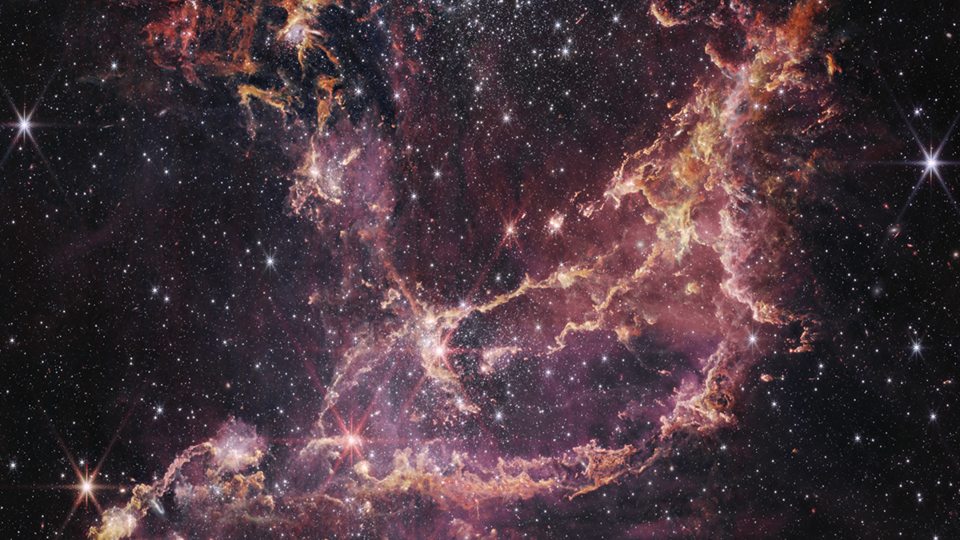Universe Update
A Star Is Born—Along with Many Questions

When it comes to understanding how stars form, astronomers are still asking plenty of questions!
The 241st meeting of the American Astronomical Society (AAS) in Seattle entered its third day today. Monday, I wrote about JWST, and yesterday, I described work on exoplanets. Today, I’d like to share some stories about how stars are born.
Indeed, “A Star Is Born” was the title of a plenary session at yesterday’s AAS meeting, delivered by Nia Imara from the University of California, Santa Cruz.
“Although stars represent only a tiny fraction of the mass of the entire Universe,” she said, by way of introduction, “they play an outsized role in our understanding of the Universe.”
In the course of her talk, Imara described the vast range of scales over which star formation takes place. Within our galaxy and others, there are giant molecular clouds (GMCs) where we find the coolest, densest gas—from which stars are born. Inside the GMCs, we see filaments of gas (perhaps sheets of dense gas seen from edge on) as well as knots of particularly dense regions where gravity draws gas together to form stars. A cloud of gas may collapse to form many, many small stars (so-called G stars like the Sun or even smaller K and M stars) as well as a few giant stars (O and B stars).
Imara underscored the vast range of sizes involved in understanding this process. “If an O star were the size of a blueberry, the giant molecular cloud might be the size of our planet.”
Figuring out the details of this process is an active area of research! So many talks at the AAS meeting have touched on star formation.
One of the most famous star-forming regions is the Orion Molecular Cloud Complex.
At one of today’s press conferences, Ümit Kavak from the Universities Space Research Association revealed observations of Orion by the Stratospheric Observatory for Infrared Astronomy (SOFIA), a recently retired 2.7-meter (106-inch) telescope onboard a 747. (By the way, we made a video about SOFIA a few years ago, featuring footage of the flying observatory…)
Active star formation in Orion is heating up the gas in the nebula and causing it to expand. This can be thought of as an expanding bubble that’s set to burst into the local interstellar medium.
Kavak and his team discovered outflows moving toward us at nearly 100,000 kilometers (60,000 miles) per hour! But this is happening unevenly. “The expanding shell is more like sieve,” he said, which is causing the expansion to slow down.
These observations help astronomers understand the environments in which stars are born.
Margaret Meixner, also from the Universities Space Research Association, described her JWST observations of a much larger star-forming region in the nearby Small Magellanic Cloud (SMC). This cluster of young stars, embedded in a cloud of glowing gas, is called NGC 346.
“Orion is wimpy for massive star formation; it’s just nearby,” said Meixner.“Orion has four O stars; we have hundreds.”
Her work on NGC 346 started with Spitzer data, searching for young stellar objects (YSOs), or objects that are just wrapping up their formation process and settling into their day-to-day lives as stars. Observations with JWST tripled the number of YSO candidates in her survey, giving her many more objects to study!
This is interesting not just to understand star formation happening now, but star formation as it may have been happening at its peak, about 10 billion years ago—a period some folks like to call “cosmic noon,” although I have no idea why.
The Universe today doesn’t look the same as it did then. Generations of stars have forged heavier and heavier atoms over billions of years, so today’s universe is richer in heavy elements. Astronomers have a way of measuring this called metallicity, which basically measures the fraction of elements heavier than hydrogen (you can read a good explanation of metallicity here).
Thus, some 10 billion years ago, the Universe was creating stars more prodigiously than at any time since—and it was making these stars out of relatively low-metallicity material.
That’s where the SMC comes in. Its metallicity is similar to metallicity at the epoch when we saw peak star formation, a.k.a. (sigh) cosmic noon. As Meixner describes it, that’s a period “when you’d have thousands of [NGC] 346 objects” instead of the lone NGC 346 that she’s studying.
Thus, understanding NGC 346 and star formation in the SMC could help astronomers understand star formation writ large! In the Universe as a whole…
As Imara said clearly in her talk on Tuesday, there are many outstanding questions in piecing together how stars are born: “The last thing I want to do is leave you with a sense of closure.”